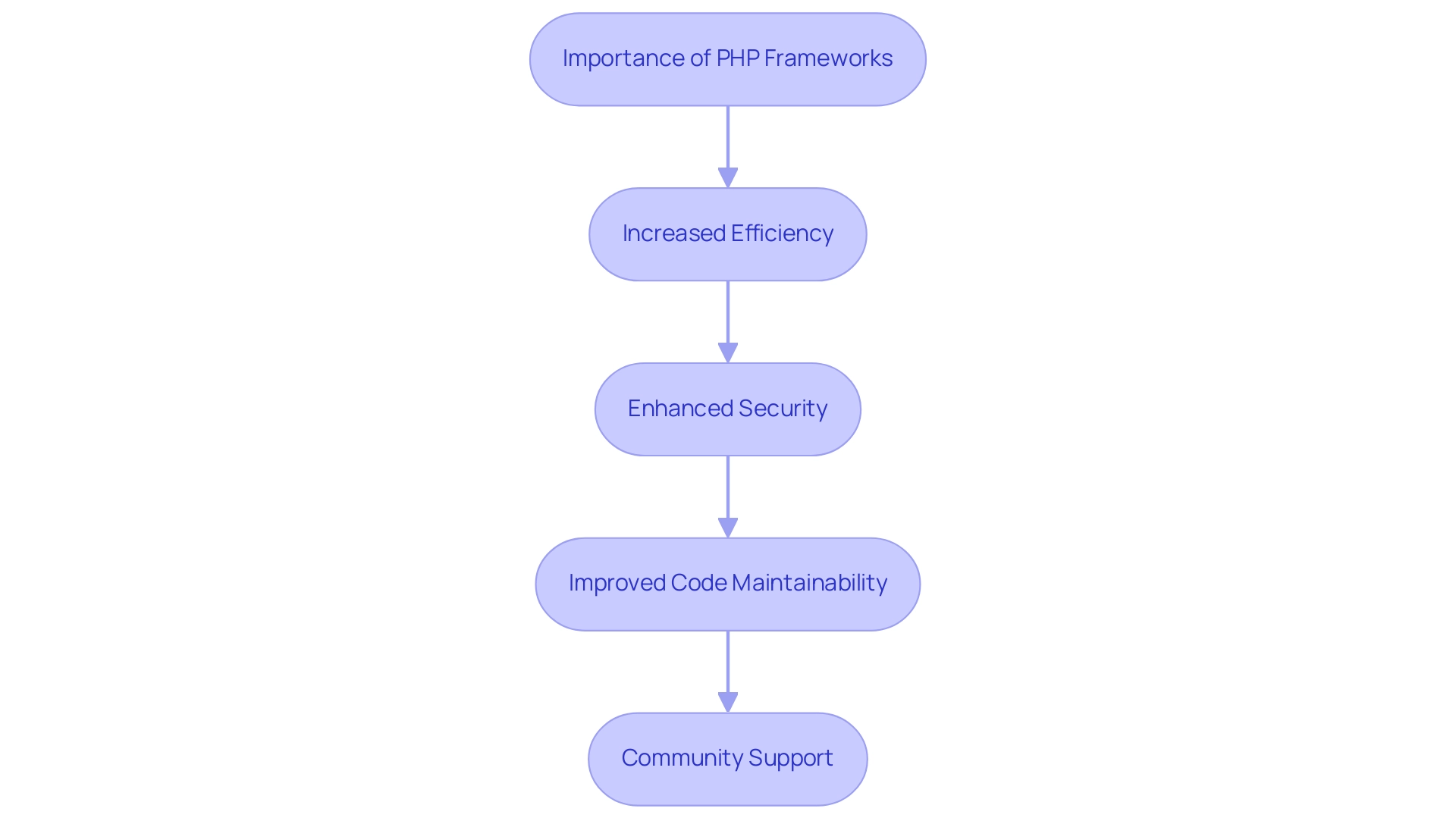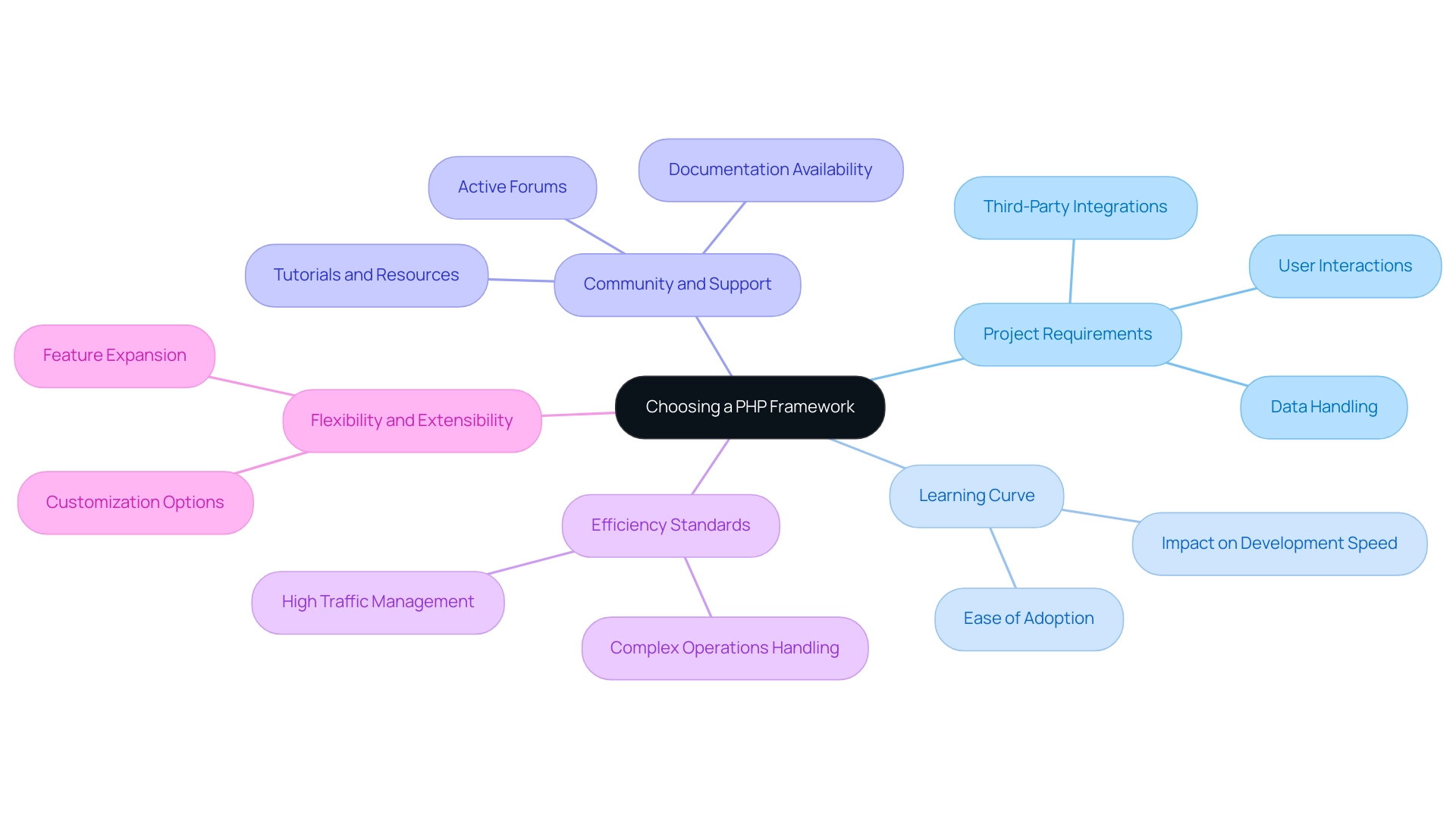Introduction
In the ever-evolving landscape of web development, PHP frameworks have emerged as indispensable allies for developers seeking to enhance their productivity and streamline their processes. By offering a structured foundation, these frameworks not only simplify the development journey but also empower teams to focus on innovation rather than repetitive tasks.
With a plethora of options available, understanding the unique benefits and features of each framework is crucial for making informed decisions that align with project goals. From increased efficiency and enhanced security to robust community support, the right PHP framework can transform a project from a daunting challenge into a seamless experience, setting the stage for success in an increasingly competitive digital world.
Understanding PHP Frameworks: Importance and Benefits
PHP structures are essential tools that streamline the development process by providing a structured foundation for building web applications. They offer numerous advantages, including:
- Increased Efficiency: Structures provide pre-built modules and libraries, allowing developers to focus on unique features rather than reinventing the wheel.
- Enhanced Security: Many structures come with built-in security features that help protect against common vulnerabilities, ensuring safer applications.
- Improved Code Maintainability: By following standardized practices, structures promote cleaner, more organized code, making it easier to maintain and update over time.
- Community Support: Popular structures have active communities that contribute to their improvement and provide resources, making it easier for developers to find solutions to problems.
Understanding these advantages is crucial as you begin to evaluate the best framework in PHP for your projects.

Key Factors to Consider When Choosing a PHP Framework
When choosing a PHP structure, consider the following key factors:
- Project Requirements: Assess the specific needs of your application, such as data handling, user interactions, and third-party integrations.
- Learning Curve: Assess how simple it is for your team to learn and adopt the system. A steep learning curve can slow down development.
- Community and Support: Look for structures with active communities that provide documentation, forums, and tutorials, which can be invaluable during development.
- Efficiency Standards: Consider the system's efficiency standards and how well it manages high traffic and complex operations.
- Flexibility and Extensibility: Ensure the system allows for customization and can be easily expanded with additional features as your initiative evolves.
By weighing these factors, you'll be better positioned to choose a structure that aligns with your goals.

Comparative Overview of the Top PHP Frameworks in 2024
Here’s a comparative overview of the top PHP frameworks in 2024:
-
Laravel
- Pros: Elegant syntax, robust features, strong community support, ideal for building REST APIs
- Cons: Can be resource-intensive for smaller projects
-
Symfony
- Pros: Highly flexible, reusable components, enterprise-level support, perfect for large-scale applications
- Cons: Steeper learning curve, more complex setup
-
CodeIgniter
- Pros: Lightweight, easy to learn, excellent for small projects, quick setup
- Cons: Limited built-in features compared to others
-
Yii
- Pros: High performance, exceptional for large applications, strong AJAX support, and caching. Known for its community-driven support and efficiency in large-scale web development, as highlighted in its case study.
- Cons: Less popular, smaller community
-
CakePHP
- Pros: Rapid development, convention over configuration, great for prototyping
- Cons: Less flexibility for complex applications
This overview highlights the strengths and weaknesses of each framework, empowering you to choose the one that best aligns with your project requirements.
When choosing a structure, it’s essential to consider the costs and licensing terms, as PHP solutions generally adopt permissive open-source licenses like MIT or Apache. As a reminder, consider the costs and licensing terms of a PHP structure before making a decision.
Choosing the Right Framework for Your Project Needs
Selecting the right PHP framework for your project requires careful consideration of specific scenarios:
- Laravel: This framework excels in large-scale applications, offering a comprehensive feature set and a vibrant community for ongoing support. Its built-in unit testing capabilities allow developers to ensure code quality and detect bugs effectively, making it a reliable choice for substantial endeavors. Additionally, Laravel supports automated code debugging, enabling instant identification and resolution of codebase issues. As Stuti Dhruv, Senior Consultant at Aalpha Information Systems, states, "The goal of a unit test is to ensure that each part of the program is working fine as an isolated system." A case study titled 'Unit Testing in Laravel' illustrates how this feature aids in spotting bugs and guarantees that each component of the system operates properly prior to deployment, ultimately improving efficiency and ensuring security compliance.
- Symfony: Considered the best framework in PHP for enterprise-level solutions, Symfony provides the flexibility and customization required to meet complex project demands while supporting agile testing to catch bugs early in the development process. Its robust debugging tools assist in maintaining code quality and enhancing efficiency.
- CodeIgniter: For small to medium-sized projects, or for developers seeking the best framework in PHP, CodeIgniter offers simplicity and ease of use, allowing for quick deployment of changes as part of your existing release process. Its lightweight structure ensures efficient operation without compromising security.
- Yii: When exceptional speed and efficiency are crucial, Yii emerges as the best framework in PHP, designed for systems that necessitate effective processing without sacrificing security standards. Yii's automated debugging features allow developers to quickly identify and resolve issues, ensuring optimal performance.
- CakePHP: As the best framework in PHP for rapid application development, CakePHP leverages conventions that can significantly accelerate timelines, while also ensuring alignment with security best practices. Its built-in debugging tools facilitate quick identification of code issues, enhancing overall code quality.
By aligning the particular requirements of your initiative with the advantages of each structure, you enable yourself to make a more informed and strategic choice that boosts efficiency and productivity.
Long-term Considerations: Maintenance and Community Support
When selecting a PHP framework, it's essential to consider several long-term factors that can significantly impact your project's success:
- Maintenance: Opt for a framework that is actively maintained and frequently updated. This ensures that your project remains compatible with emerging technologies and receives timely security patches, which are critical to safeguarding your application.
- Community Support: A robust community can be invaluable, offering ongoing assistance, resources, and a wealth of plugins. This support is crucial for troubleshooting issues and enhancing the system's functionality. Metrics indicate that structures with strong community backing tend to have higher adoption rates and more frequent updates, underscoring the importance of this aspect in your selection process.
- Documentation: Comprehensive documentation is a hallmark of well-supported systems. It facilitates easier onboarding for new developers and streamlines troubleshooting for existing team members, ultimately enhancing productivity. A thorough documentation process can reduce development time and minimize errors.
- Migration Path: Evaluate the ease of upgrading or migrating to newer versions of the system. A clear migration path is vital for long-term sustainability, allowing your application to evolve without significant disruptions.
Moreover, consider particular structures such as Yii 2, recognized as the best framework in PHP, which excels in handling AJAX and offers strong caching support, making it a solid choice for endeavors that demand high efficiency and responsiveness.
It's also important to evaluate the option between utilizing the best framework in PHP and a structure-less method, as this decision relies on complexity, efficiency requirements, security factors, and team expertise. For instance, a framework-less approach may be the best choice when performance is critical, complete control and customization are required, or for small, simple tasks, as highlighted in the case study titled 'When to Choose a Framework-Less Approach.'
Concentrating on these factors will enable you to choose a structure that not only meets your current needs but also adjusts to your initiative's expansion and evolving demands. Remember, as stated by industry experts,
Consider the costs and licensing terms of a PHP framework before making a decision.
By factoring in maintenance, community support, and documentation, you'll set your project up for lasting success and efficiency.
Conclusion
Choosing the right PHP framework is a pivotal decision that can significantly influence the success of web development projects. By understanding the importance and benefits of PHP frameworks, developers can leverage their structured foundations to enhance efficiency, security, and maintainability. Each framework, from Laravel's robust features to CodeIgniter's simplicity, offers unique advantages tailored to different project needs.
When selecting a PHP framework, it's essential to evaluate key factors such as:
- Project requirements
- Learning curves
- Community support
- Performance benchmarks
This careful consideration ensures that the chosen framework aligns with specific project goals, ultimately fostering innovation while minimizing repetitive tasks. Moreover, the comparative overview of top PHP frameworks highlights their strengths and weaknesses, empowering developers to make informed choices that enhance productivity.
Long-term considerations, including maintenance, community support, and comprehensive documentation, further reinforce the importance of selecting a framework that can adapt to evolving project demands. By prioritizing these factors, developers can ensure their projects are not only successful upon launch but also sustainable and efficient in the long run. Embracing the right PHP framework sets the stage for transformative development experiences, paving the way for innovation in an increasingly competitive digital landscape.
Frequently Asked Questions
What are the advantages of using PHP structures for web application development?
PHP structures streamline the development process by increasing efficiency through pre-built modules, enhancing security with built-in features, improving code maintainability with standardized practices, and providing community support from active user groups.
What key factors should I consider when choosing a PHP structure?
Important factors include project requirements (data handling, user interactions, integrations), learning curve (ease of adoption), community and support (availability of documentation and resources), efficiency standards (performance under traffic), and flexibility/extensibility (ability to customize and expand).
Can you provide an overview of the top PHP frameworks in 2024?
- Laravel: Elegant syntax and strong community support, ideal for REST APIs but can be resource-intensive for smaller projects. - Symfony: Highly flexible and suitable for large-scale applications, though it has a steeper learning curve. - CodeIgniter: Lightweight and easy to learn, great for small projects, but has limited built-in features. - Yii: High performance for large applications with strong AJAX support, but has a smaller community. - CakePHP: Rapid development with a focus on conventions, good for prototyping but less flexible for complex applications.
What specific scenarios are best suited for each PHP framework?
- Laravel: Best for large-scale applications needing comprehensive features and unit testing. - Symfony: Ideal for enterprise-level solutions requiring flexibility and agile testing. - CodeIgniter: Suitable for small to medium-sized projects needing simplicity and quick deployment. - Yii: Excellent for projects requiring exceptional speed and efficiency. - CakePHP: Perfect for rapid application development with a focus on security and conventions.
What long-term factors should I consider when selecting a PHP framework?
Consider maintenance (active updates), community support (availability of resources), documentation (ease of onboarding and troubleshooting), and migration path (ease of upgrading to newer versions).
When might a framework-less approach be preferable over using a PHP framework?
A framework-less approach may be best when performance is critical, complete control and customization are needed, or for small, simple tasks.




